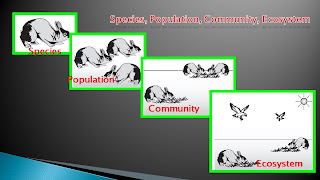
Tuesday, May 10, 2011
Chapter 4(4.2)-Interaction between living organisms-Symbiosis
Symbiosis/共生/kehidupan bersama
1. Commensalism/片利共生/ Komensalisme
Commensalism is a class of relationship between two organisms where one organism benefits but the other is neutral (there is no harm or benefit)
片利共生 是指在生物界中,某两物种间的生态关系,其中一种的生物会因这个关系而获得生存上的利益,但是,另一方的生物在这个关系中,并没有获得任何益处,但也没有获得任何害处,只是带动对方去获取利益。
Komensalisme adalah hubungan di antara dua organisma di mana salah satu pihak beruntung manakala pihak kedua tiada kesan( samada untung ataupun rugi)
2. Mutualisme/互利共生/ Mutualisme
Commensalism is a class of relationship between two organisms where both organisms benefit.
互利共生 是指在生物界中某两物种间的一种互相依赖、双方获利的专性共生关系.
Mutualisme adalah kedua-dua pihak mendapat manfaat.
3. Parasitisme/寄生/ parasitisme
Commensalism is a class of relationship between two organisms where one organism benefits and the other one is harmed.
寄生 其中一種的生物获利而另一方受损。
Mutualisme adalah hubungan di mana satu pihak beruntung tetapi membahayakan pihak kedua.
Thursday, May 5, 2011
Chapter 4(4.1)-the interdependence among living organisms(Species, Population, Community, Ecosystem)
Wednesday, May 4, 2011
Chapter 3-variety of living organisms and their classification(Type of fertilisation for vertebrate)
i. External fertilization/体外受精
External fertilization is a form of fertilization in which a sperm cell is united with an egg cell external to the bodies of the reproducing individuals.
体外受精是一种精子与卵子在雌性生物体外结合产生配子的一种受精方式。在这种受精形式下,精子可利用在水中运动的能力,游向卵子并与其结合。行体外受精的生物包括许多鱼类与两栖类,以及部分的植物。
ii. internal fertilization/体内受精
In contrast, internal fertilization takes place inside the female after insemination through copulation.
体内受精是一种精子与卵子在雌性生物体内结合产生配子的一种受精方式。行体内受精的生物包括许多爬虫类与鸟类,以及大部分的哺乳动物。





